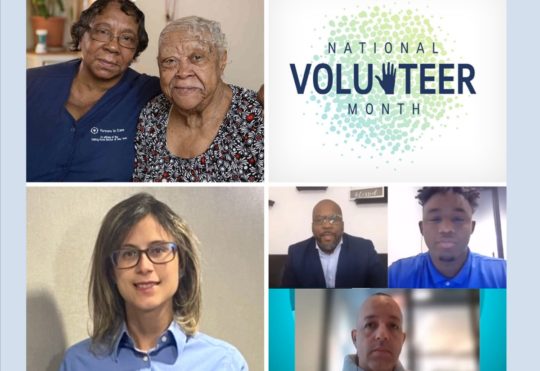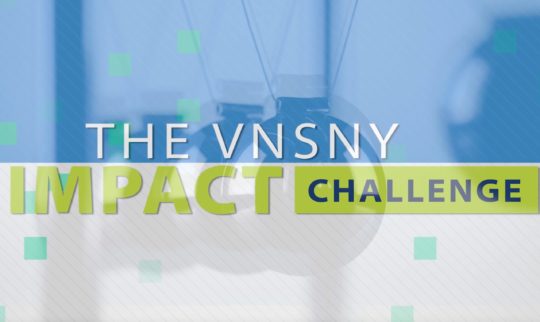An Interview with Dr. Ritchell Dignam—Delivering Home and Hospice Care During the Pandemic
 Dr. Ritchell Dignam is Chief Medical Officer for VNSNY Provider Services and also serves as Hospice Medical Director for VNSNY Hospice and Palliative Care. With more than three decades of experience as a geriatrician, she has played a key leadership role during the current COVID-19 pandemic, helping to develop clinical protocols for the organization and keeping staff updated on measures for avoiding exposure to the coronavirus.
Dr. Ritchell Dignam is Chief Medical Officer for VNSNY Provider Services and also serves as Hospice Medical Director for VNSNY Hospice and Palliative Care. With more than three decades of experience as a geriatrician, she has played a key leadership role during the current COVID-19 pandemic, helping to develop clinical protocols for the organization and keeping staff updated on measures for avoiding exposure to the coronavirus.
“We’re so very lucky to have Dr. Dignam as our Chief Medical Officer for Provider Services,” says Andria Castellanos, EVP and Chief of Provider Services. “Dr. Dignam is a talented physician leader who has led us through this unprecedented time period with a steady hand, always putting the safety of our staff and patients at the forefront.”
How does the COVID-19 pandemic compare to other public health crises you have dealt with?
We’ve never seen a crisis of this magnitude, either in the regular flu season every October through April, or the measles outbreak of 2018-2019. Both measles and the flu are contagious, but we have a defense against their outbreaks in the form of increased immunization through vaccination combined with increased public awareness through education and public ads. With COVID-19, we’re still struggling to fully understand the nature of this virus and how to mitigate community spread in a population that does not have immunity. In addition to the strain of dealing with high rates of infection among the public and the need for social distancing, this pandemic has put a lot of pressure on healthcare workers, who are at particular risk of infection through their jobs.
What will it take to bring things back to normal?
We have to continue efforts to improve contact tracing and expand testing capabilities and sites, including antibody testing. At the same time, of course, the medical community and scientists globally are working towards finding a cure and a vaccine to avoid recurrence of this pandemic crisis. In New York City, we are beginning to see a flattening of the curve, but we all need to stay vigilant, stay the course and follow social distancing, cough etiquette and practice good hand-washing technique.
How is VNSNY’s work with COVID-19 positive or presumptive positive patients impacting VNSNY Home Care and Hospice?
In the middle of March, Hospice started caring for COVID-19 positive patients at the general inpatient settings. During the first week of April, both Home Care and Hospice started caring for COVID-19 positive patients discharged from the hospitals in the home. We were able to take these referrals because we secured the necessary PPE. Additionally, we were able to create care protocols incorporating information from the CDC, the New York State DOH, and importantly, feedback from our frontline staff. The safety of our workforce and our patients is always the top priority at VNSNY. The nationwide shortage of PPE is a very serious issue in this regard, and we’ve been working aggressively to obtain PPE from any and all sources, including the government, private companies, and donations.
What are some of the special challenges that COVID-19 presents for hospice care?
For VNSNY, the key to good hospice care is caring for the patient and family as one unit, empowering family and caregivers to provide care, and allowing dying patients to be surrounded by their loved ones and caregivers. But with COVID-19, many families are limited in their ability to visit loved ones in nursing homes or assisted living facilities, or when they’re hospitalized with COVID-19. So we now have patients dying in isolation from their families and friends. Many bereaved families must forego final embraces and consolation to adhere to social distancing requirements, and religious ceremonies are also affected when gatherings are not permitted. It’s also been difficult, logistically and emotionally, for VNSNY hospice staff, who face the same restrictions on access to patients. We’re still doing home visits if families allow but fear of infection affects everyone.
Can “virtual visits” take up some of the slack?
Virtual visits using telehealth are a new strategy for VNSNY Hospice—but in situations where we can’t get access to the patient and there’s no need for bedside interventions or wound care, we’re embracing telehealth. Virtual visits also allow us to safely provide bereavement support to families, which continues in some form for 13 months after the death of a loved one.
The surge in deaths has put a great deal of pressure on physicians and funeral homes. How does that affect the work of VNSNY Hospice?
The impact is felt first by families and it adds to their stress at a difficult time, even when COVID-19 is not a factor. It’s sometimes difficult to reach community attending physicians—many of whom are helping with the crisis—to certify deaths in a timely manner, but VNSNY Hospice physicians are stepping in to complete death certificates. There have also been delays in transfers to funeral homes, which are dealing with so many deaths. They’re following new CDC guidelines to avoid COVID-19 exposure to their staff and are facing the same PPE shortages as health care workers. VNSNY hospice teams are now working closely with families to put funeral arrangements in place before death, to avoid delays as often as possible and ease the additional emotional burden that families are experiencing during this crisis.
How are you relaxing, if that’s possible, with what must be a 24/7 job right now?
I always find time to take care of myself so that I can take care of my family and others. I’m exercising at home and going for a three-mile walk every day the weather allows. And of course, there’s Netflix. I’m a big fan of The Crown and I’m waiting for the next season of Outlander!

